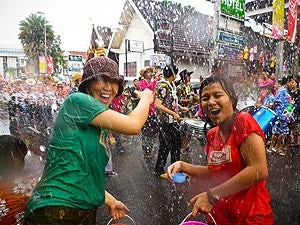 |
| Photo by echo0101 through a Creative Commons license |
ยังมีอีกที่ ภาษาไทย
Most of the world celebrates New Year with fireworks. In Thailand we welcome the New Year, in April, with water. During “Songkran” (Thai New Year), we pour scented water on the hands of our elders as a show of respect and to receive their blessings. It’s also a very festive celebration that’s marked by entertainment, water fights that spill into the streets, and a huge amount of people travelling by road to spend the holidays with their families and friends.
When things get out of hand, the situation becomes a recipe for disaster. During the Songkran week of 2012 alone, according to the government’s Road Safety Directing Center (pdf in Thai), there were 320 deaths and 3,320 people injured by road traffic crashes, mostly from drunk driving. Every Songkran becomes a reminder that road traffic injuries and fatalities are still a major public health and development challenge in Thailand.
Let’s take a closer look at the figures. According to the Thailand Road Traffic Accident Situational Report 2010, over 12,000 persons are killed in road traffic crashes, with nearly 100,000 people injured, and thousands of people crippled for the rest of their lives.
In Thailand, road traffic deaths and injuries disproportionately affect the poor, who have limited means to cope with the losses brought about by accidents. Hospital records show that 75-80% of road traffic injuries and 70-90% of road traffic deaths in Thailand involve motorcyclists – most of whom are poor.
It is also important to note that young people in Thailand are particularly vulnerable to road traffic crashes. According to the International Health Policy Program’s Burden of Disease Working Group, road traffic injuries are the top cause of death among males aged 15-29 and the second top cause of death among females in the same age range.
As road accidents affect people of working age, it silently –though enormously- contributes to loss in productivity in Thailand. This is due to the number of years lost to disability and death. The Ministry of Health also said that road accidents are a cause of high spending on health.
The Royal Thai Government is addressing road safety issues. It introduced the “Decade of Action” program which aims to reduce road accidents from the current rate of 20 per 100,000 persons to below 10 per 100,000 persons by the year 2020. However, this is no easy task and everyone will have to do their part in making roads safer. The root causes of road accidents also have to be tackled. It isn’t uncommon to see children riding on motorbikes or at the back of open air pick-up trucks. There are behavioral issues (e.g. driving under the influence of alcohol or drugs, driving without a helmet, use of mobile phone while driving, driving without a safety belt) and also infrastructure and system challenges (e.g unsafe road conditions, unsafe vehicles, poor emergency medical service, and post-crash management systems).
What can be done? To start, people should wear helmets when they ride motorbikes. Children shouldn’t be riding motorbikes or the back of open air pick-up trucks either. We also have to think about improving public transport options for the poor. Thailand needs to improve governance and enforcement aspects, particularly on how to develop a proper road safety management system and how to effectively enforce road safety rules and regulations. To succeed, government agencies, civil society, development partners, the private sector, and individuals should do their bit to make roads a safer place for everyone.
We should aspire for a Songkran that marks a new year with much fewer road accidents in Thailand.


Join the Conversation